
TOP Mexican Candies: 20 Irresistible Treats You Can’t Miss
Typical Mexican candies are a tradition and a delicacy that gladdens the heart.
These delicious sweets were born thanks to the mixture of ingredients from our land and those from other countries.
Anyone visiting Mexico should try any of them at some point.
For example, Mexican-grown peanuts and cocoa were blended with ingredients like milk and sugar from European countries.
In fact, sweets have always been present during the celebrations of the towns around Mexico, where they were thrown as gifts and later served as prizes to reward the workers.
Mexican candies are everywhere, as you can find them in all sorts of festivities, weddings, meetings, etc.
For this reason, confectionery is part of our heritage and culture. Here are the 20 most popular candies in Mexico; take note:
Top 20 Mexican Candies
1. Pepitorias, more than a Mexican Candy

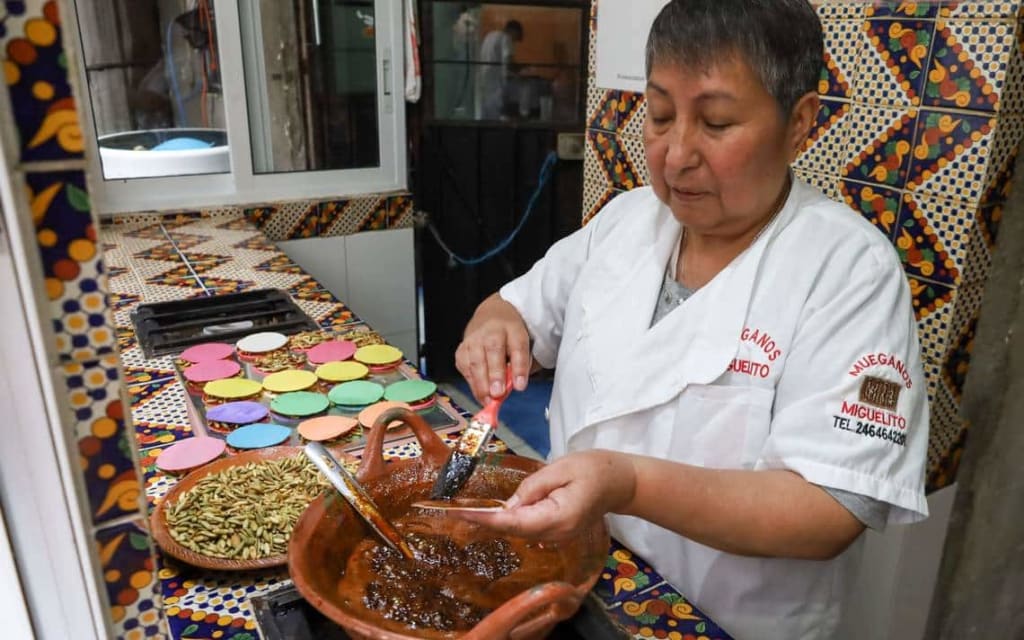
Maybe you don’t know which Mexican candy to try first, but don’t worry.
I’ll start my top 20 list with these wafers with toasted pumpkin seeds.
Also called pepitorias originating from Colima and Zacatecas, I bet you’ve tried them somewhere at least once in your life.
For me, the tastiest ones are made with wheat flour, water, piloncillo honey, and pumpkin seeds.
These delicious wafers usually come in bright colors like pink, blue, green, white, and yellow.
If you want to try them, you will probably find them in markets, typical candy stores, parks, or street stands.
2. Sweet Glorias
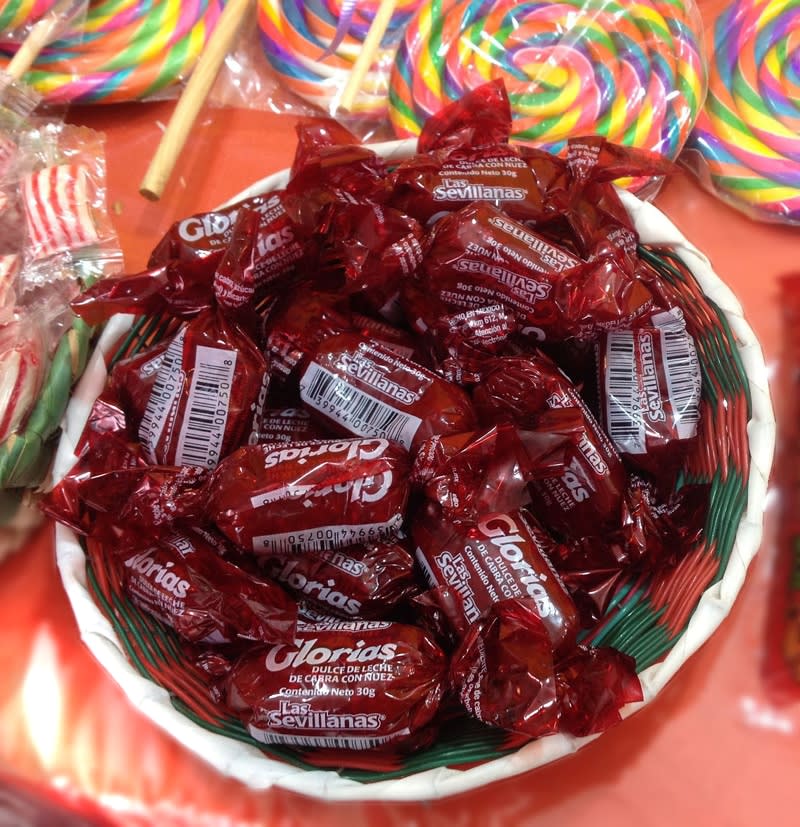
Undoubtedly, burnt sweet glorias cannot be missing from this list since they are delicious to the palate. It was invented in the region of Linares, Nuevo Leon.
The glorias are made with only two ingredients: burnt milk and walnuts wrapped in their peculiar red cellophane paper.
A lady called Natalia Medina Núñez was the one who started the elaboration of this delicious treat.
The people who tried them had great acceptance and said, “Those candies taste like glory,” hence the name.
3. Borrachitos
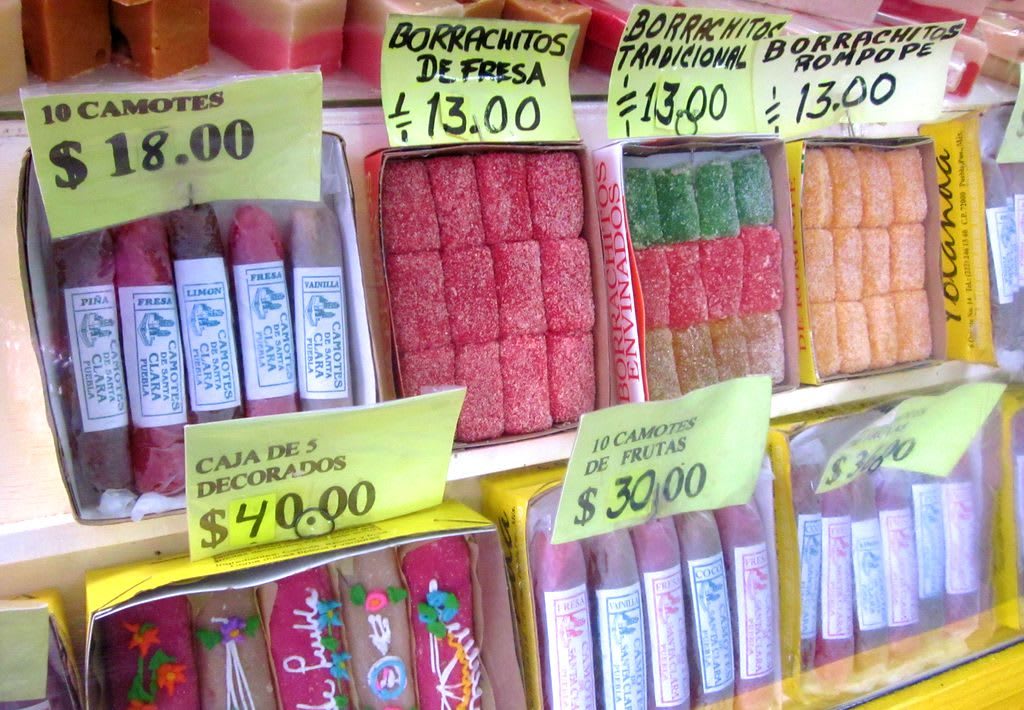
The Borrachitos (drunken candies) are typical sweets made from a combination of corn starch, fruits, and some liquor such as rompope, rum, tequila, cognac, etc.
In the past, convents used to make borrachitos to thank the church’s benefactors, and later they started selling them in downtown Puebla.
You will find them anywhere in Mexico, especially in local markets. They are super good, so don’t hesitate to try them.
4. Marzipan: One of the most beloved Mexican candies!
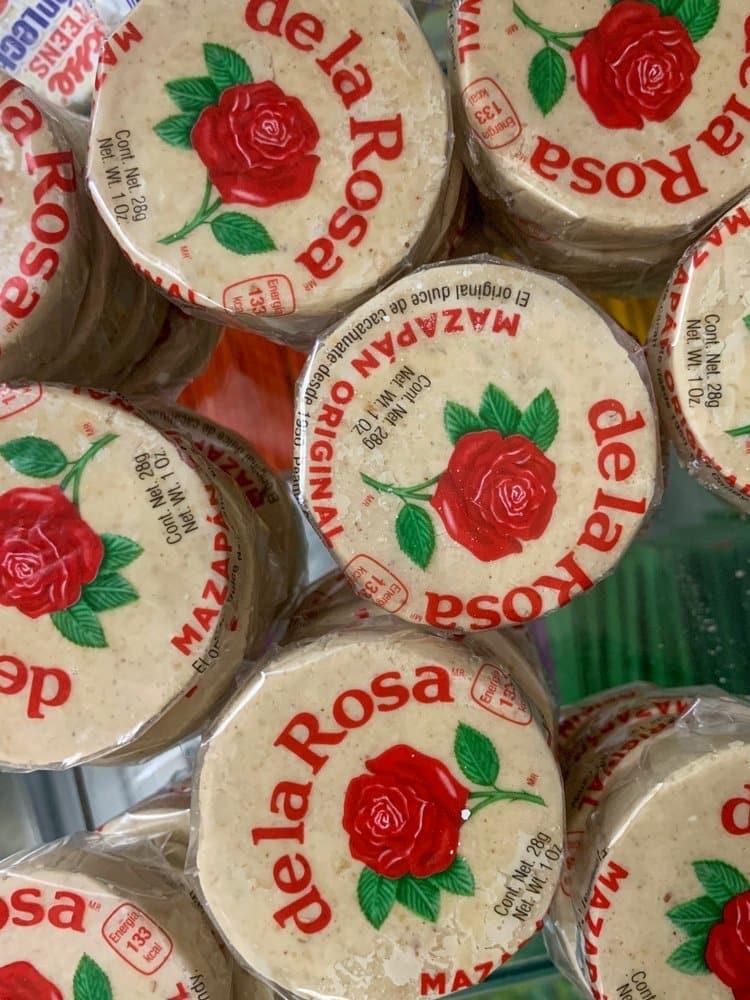
What’s marzipan? It’s a sweet made with almonds, sugar, and egg, in different proportions depending on the recipe.
It was brought to Mexico by the Spaniards and later became re-invented in the convent of San Clemente de Toledo in 1214.
In Mexico, it is commonly made with peanuts instead of almonds.
This candy became popular in Mexico in the 1950s thanks to a company from Jalisco that gave a different touch to its elaboration, making it stand out.
Even though there are many brands of Mexican candy, the one that stands out the most is De La Rosa, a company with more than 70 years of experience making marzipan and other popular candies.
5. Meringues

What is the origin of meringues? The legend says it was invented around 1600 by the Italian pastry chef Gasparini, a resident of Meiringen, a Swiss town, hence its name.
In the past, “merengueros” used to stand outside Mexican schools and play volados (coin flipping) with the children to get a better deal. I remember those times in my school.
However, for some reason, the merenguero always won.
This typical Mexican candy elaborates on egg whites, sugar, and a little coloring, and some even add a touch of pulque, so don’t hesitate to try a meringue!
6. Cocadas

Coconuts are abundant on the coasts of Mexico; that’s why they take advantage of this delicious fruit and make the best out of it by producing cocadas.
What is a cocada? It is a typical Mexican candy made from grated ripe coconut, water, fresh milk, cinnamon, and sugar.
Cocadas go by several names such as alfajor, cocada horneada, coche, dulce de coco, greñuda and rompemuelas.
The preparation of these sweets involves grated coconut, sugar, and egg yolks; they are baked until acquiring a golden and crunchy form.
You can find them in orange, white, or any other custom color.
7. Tarugos

A Tarugo is nothing more than tamarind fruit mixed with sugar, lime juice, and chile.
These delicious spicy sweets are ubiquitous in Guerrero, Michoacán, Oaxaca, Yucatán, and Chiapas.
By the way, Mexico is one of tamarind’s leading producers and consumers.
Even if you don’t like spicy, don’t worry because you can find a sweet version. It’s the same but chili-free.
8. Las Alegrías
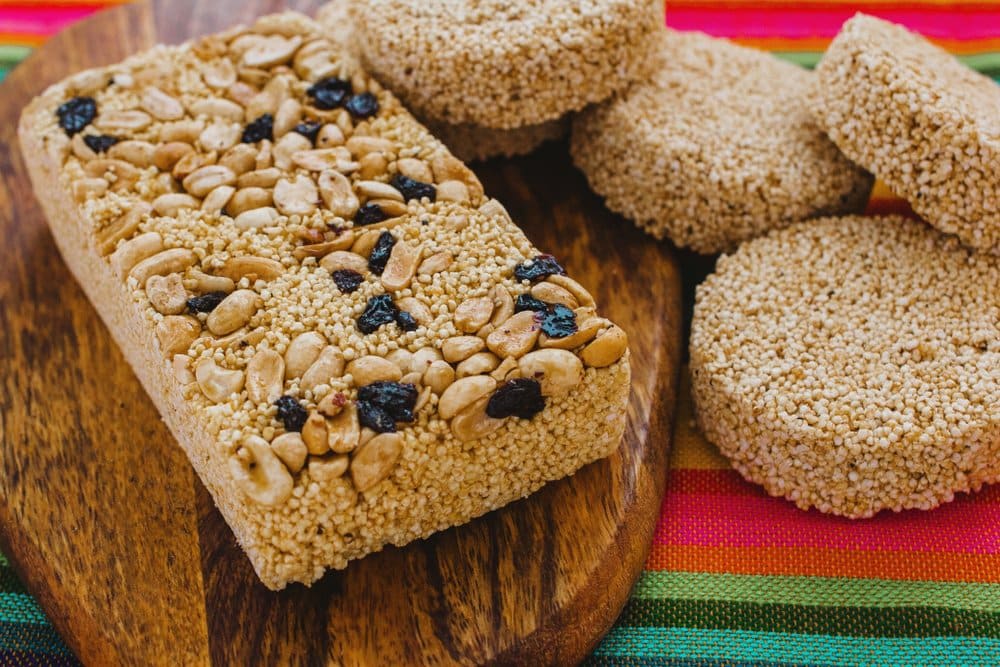
The first candy in Mexico was the alegrías since it served as an offering to venerate the gods, thus becoming an ancestral sweet.
A spooky story says that at that time, amaranth was mixed with the blood of sacrificed people with a bit of mead and honey.
Alegria means “joy”
But as time passed, the blood was changed for raisins, pepitas, and piloncillo.
Brighten up your day by eating an alegría. Besides being very nutritious, they are one of the most consumed in Mexico and originate from Santiago Tulyehualco Xochimilco.
Why are they called alegrías?
They are so-called because when the amaranth seeds are toasted on the comal, they vibrate so much that they seem to jump for joy!
9. Dulces de Camote
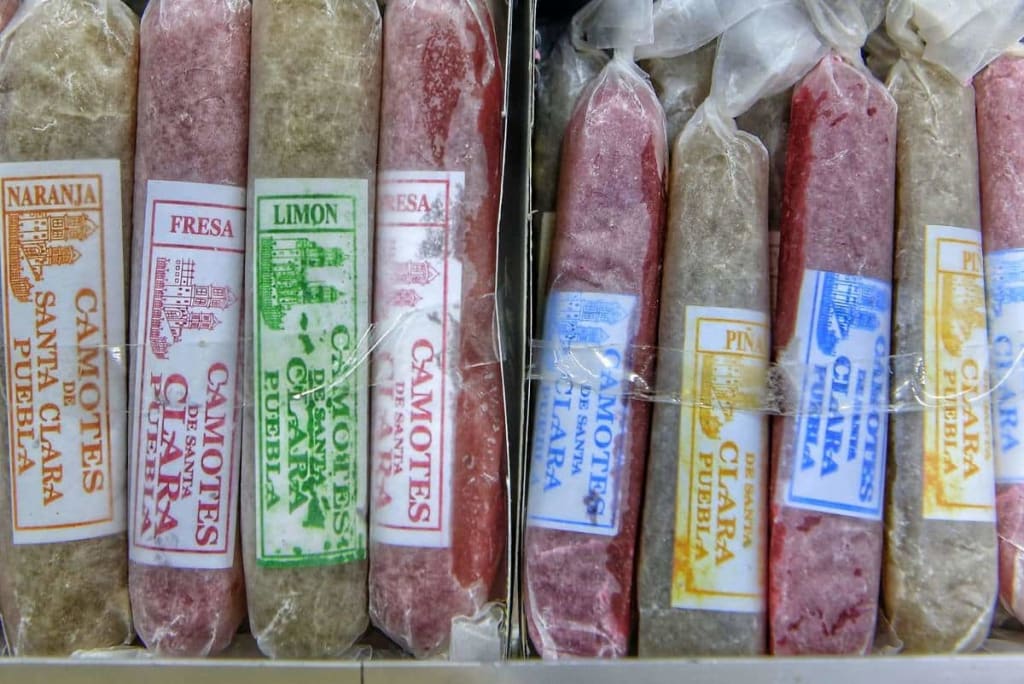
One of the sweets you must try is the caramelized sweet potato (called camohtli in Nahuatl).
This tuber has been cultivated for more than 8,000 years.
Because of a prank in a convent, the mixture we know today as caramel sweet potato was born, and you can find it in various flavors such as strawberry, pineapple, or orange.
One of the best sweets you can try (it is one of my favorites).
10. Palanquetas, a Mexican candy for peanut lovers
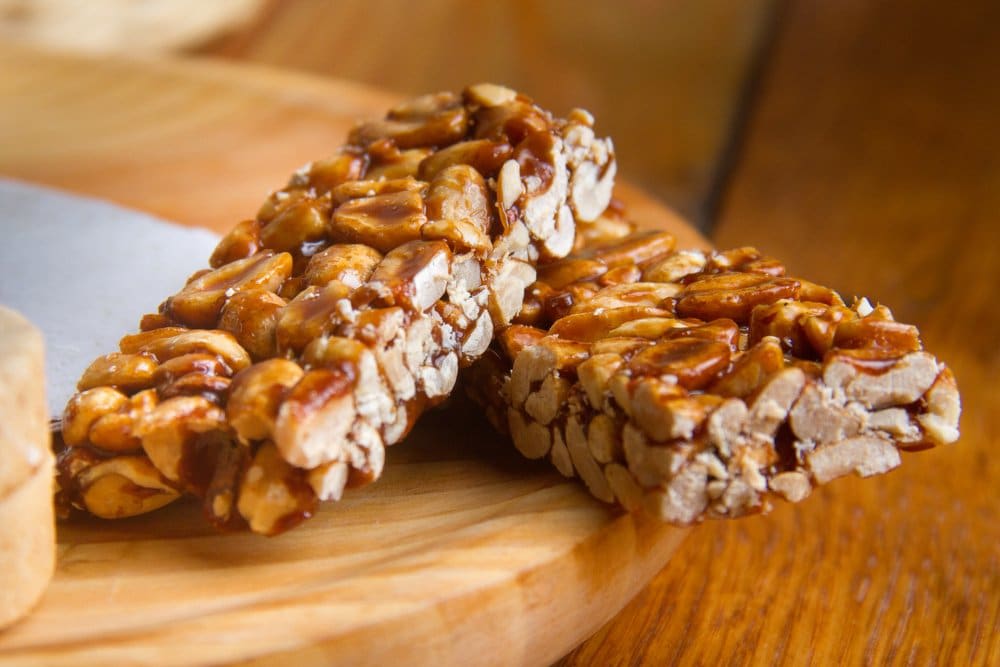
The palanqueta is a delicious peeled and shelled peanut bar mixed with piloncillo syrup; a crunchy solid texture characterizes it.
Its name derives from the Nahuatl voice “papaquili,” which means happy, and its flavor is incredible.
The Palanqueta was also one of the first candies in Mexico. At first, they were made with roasted corn and honey, but that changed after the Spanish conquest.
Nowadays, they are made with peanut pieces, water, sugar, and vegetable oil, although they can also be made with pumpkin seeds.
I highly recommend them since they are healthy and delicious.
11. Mueganos
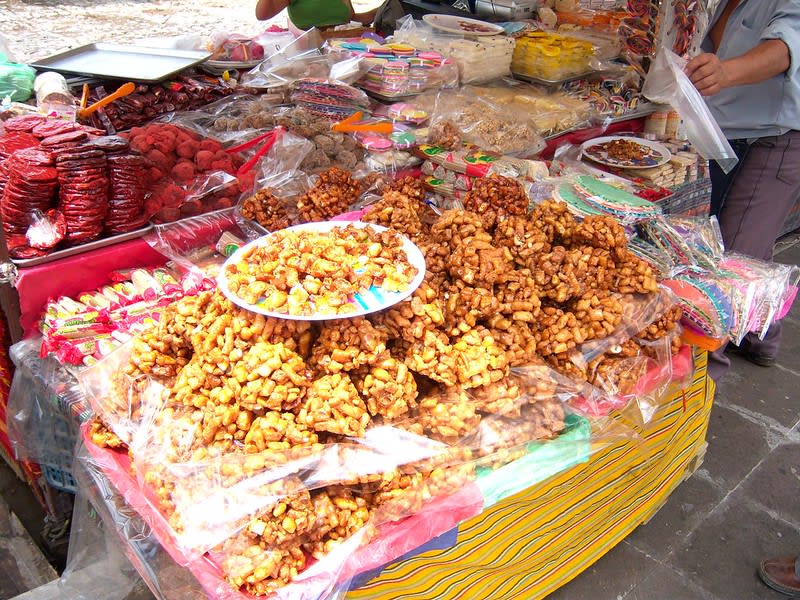
Another super popular candy in Mexico is the mueganos, a declared cultural and gastronomic heritage of Tlaxcala, making them incomparable.
What are mueganos?
They are small rectangular rolls made of flour, aniseed, and cinnamon, baked and coated with piloncillo. It’s hard not to crave one.
These delicacies are trendy in the towns around Mexico City like Puebla, Tlaxcala, Veracruz, and Hidalgo.
But you can also find them in most Mexican markets in the country.
12. Aniseed Bottles
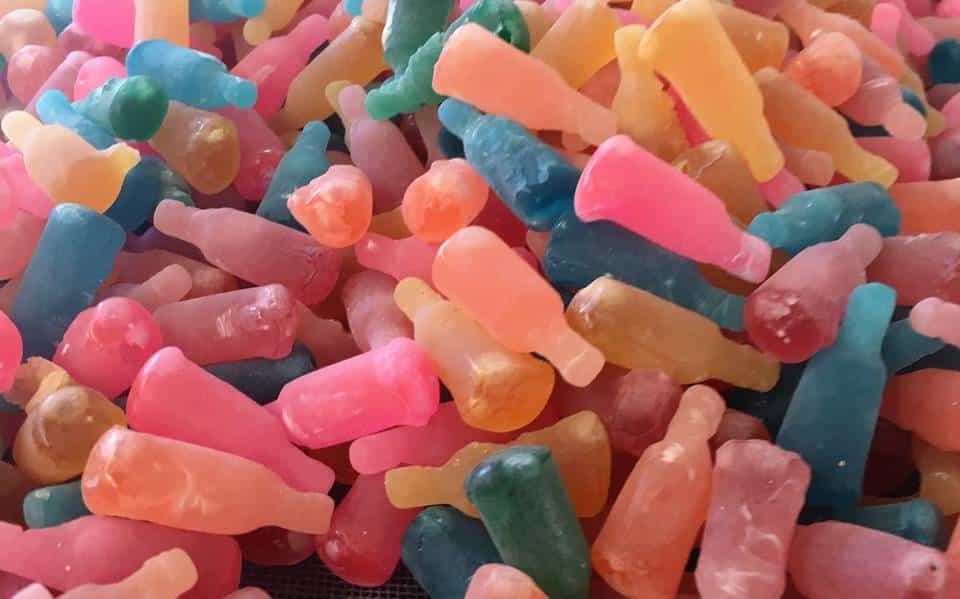
Aniseed bottles are popular Mexican candies (with the shape of a bottle) from Guanajuato that have been a tradition for more than 300 years.
For this reason, this anise candy has been taking different forms as tears in many colors, such as yellow, pink, red, blue, and white.
What is aniseed? Aniseed is a spirit of high alcohol content that gets its name from the plant’s fruit from which it is usually made (Pimpinella anisum).
13. “Garapiñado” Peanuts
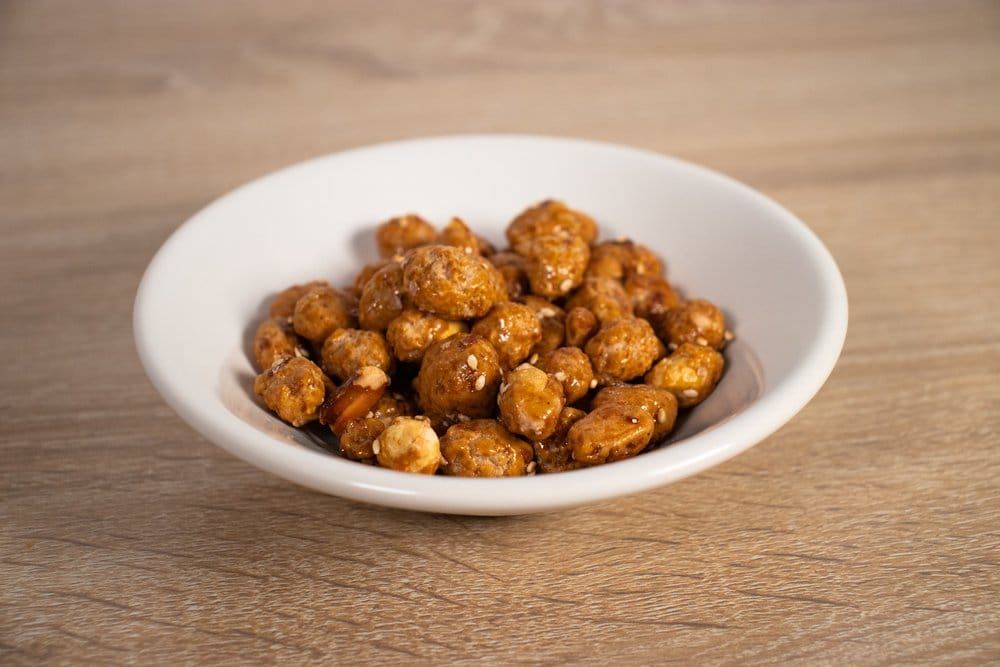
These Mexican candies will leave you with a good taste in your mouth.
You can eat them while watching a game, walking down the street, or just for the craving.
On the other hand, the garapiñado (sugar-coated) peanuts are originally from Morelos.
Their preparation is based on peeled peanuts with a sugar coating.
They have a caramel coating even though some add a touch of sesame seeds, but it depends on your taste.
Furthermore, peanuts have nutritional properties such as antioxidants and folic acid, reducing cancer risk. Now you have an excellent reason to eat them!
Peanuts are one of the most beloved typical Mexican sweets.
14. Candied Fruit
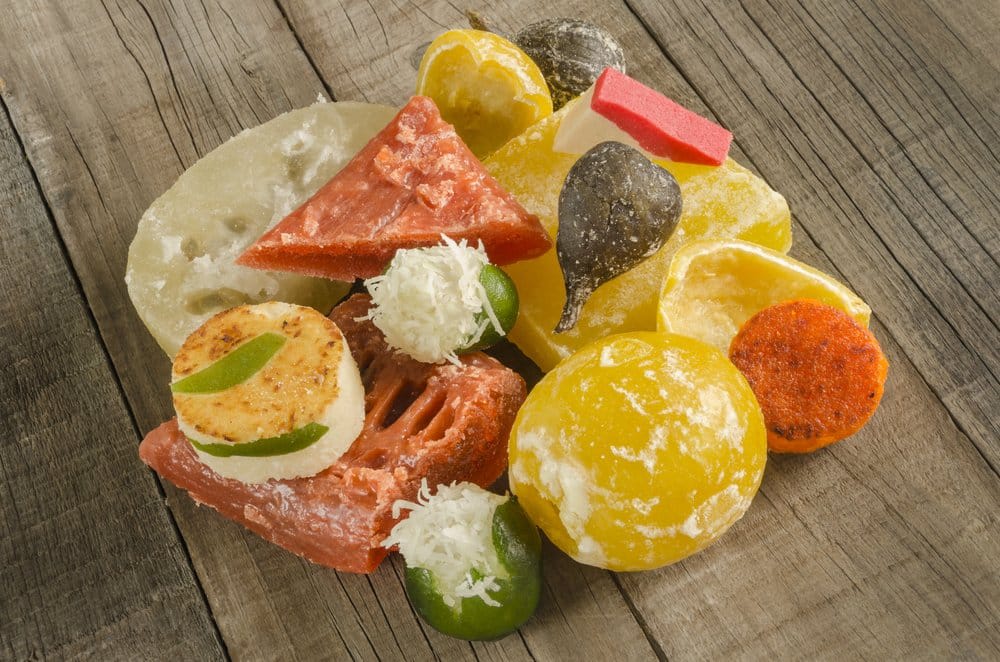
Candied fruits are tasty, no doubt. Its preparation involves a traditional method used in Xochimilco.
It is mostly consumed during Christmas and the Day of the Dead.
The elaboration process is not as complex as it sounds.
You just have to soak the fruit for a day in lime water and then submerge it in piloncillo, which is how it becomes hard.
However, the list of candied fruit is long since you can find sweet potato, apple, fig, papaya, pumpkin, orange, pineapple, chayote, prickly pear, jicama, and nopal.
15. Ate de Membrillo (quince fruit)
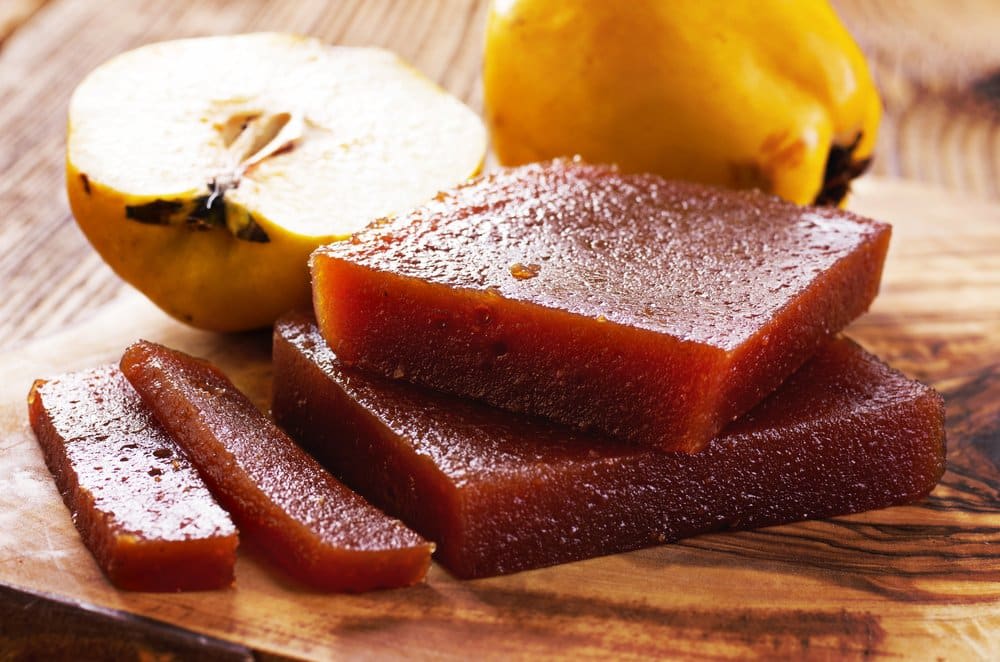
This delicious sweet was created thanks to the nuns in 1596 when they prepared a jelly based on fruit pulp.
Ate is very traditional in Michoacan.
How is ate made? It is made with quince fruit and almost any other such as apple, guava, and pear; you have surely seen them in supermarkets. Delicious!
16. Cajeta from Celaya (thickened caramel)
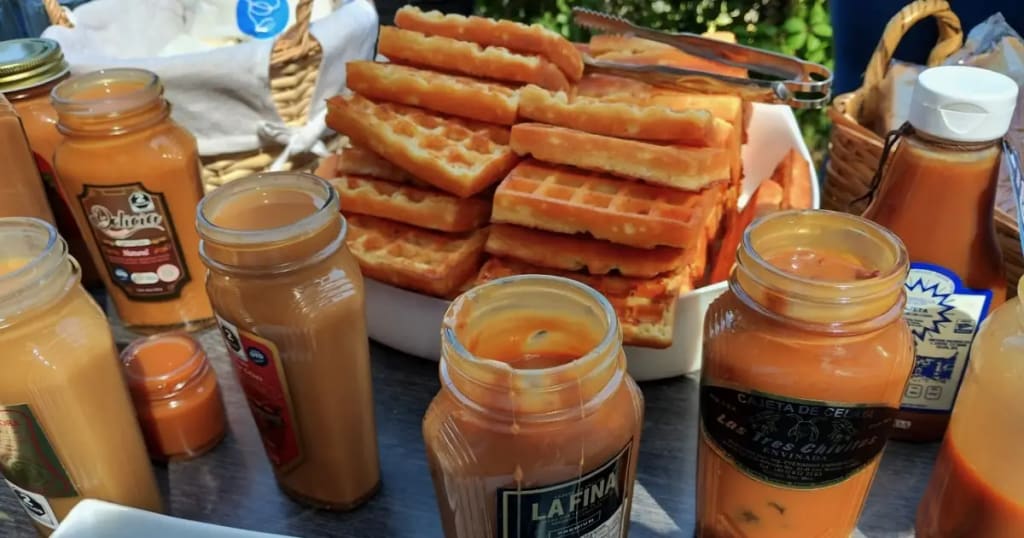
We have all eaten cajeta at some point. Haven’t you? The cajeta from Celaya is very rich and, above all, artisanal.
Try it either in some pancakes or on delicious toasted bread. It makes a yummy spread.
The city of Celaya, Guanajuato, is the leading producer of this product, they even have a Denomination of Origin these days.
The name “cajeta” comes from the wooden box used to pack them in the old days.
The elaboration of this product employs millions of families in the region who are in charge of producing and packaging it.
17. Caramelized Orange peels
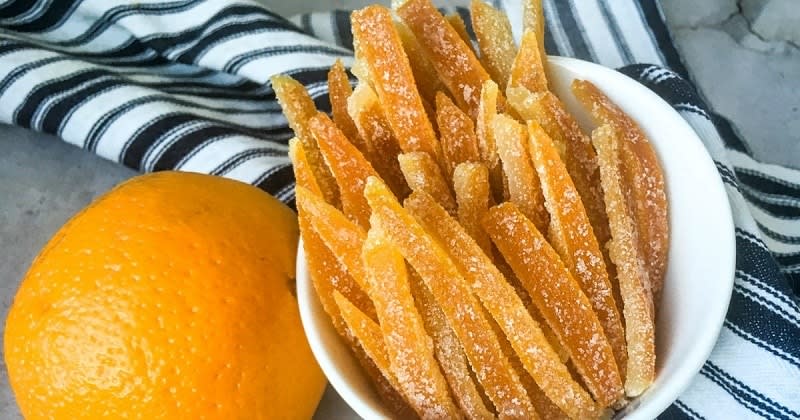
Mexicans don’t waste anything, and as proof of this, many small towns turn orange peels into candy that very few people know about.
In particular, the elaboration of this product is very easy; all you have to do is cut the oranges into strips and let them soak overnight, then boil them and add honey and sugar.
18. Guava rolls
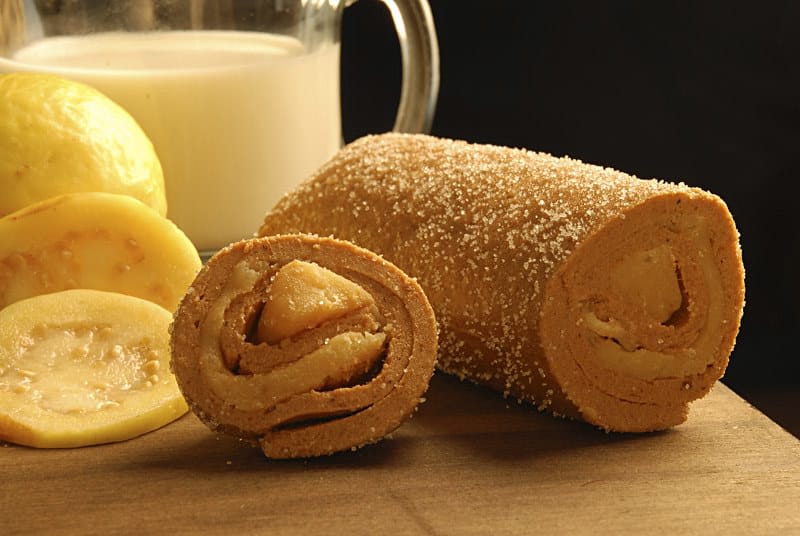
These delicious rolls are from Jaral del Progreso, Guanajuato, but they have been distributed to different areas such as Zacatecas, Jalisco, Michoacán, and Mexico City, thanks to their demand.
The best guava rolls are those made with cajeta.
There are other added flavors, but I recommend sticking with these, so always ask the vendor and ensure you’re getting the right ones.
19. Jamoncillos, a soft and tasty Mexican candy

These “jamoncillos,” which I love, are milk candies originally from Puebla, which are enjoyed by eating slowly because their sweet taste is very rich.
Whether you are in Mexico or its surroundings, you can find these delicious candies and enjoy the experience of eating one or maybe two.
The classic ones are just plain. But many others are flavored with walnuts, peanuts, raisins, pinenuts, etc.
20. Tortitas de Santa Clara
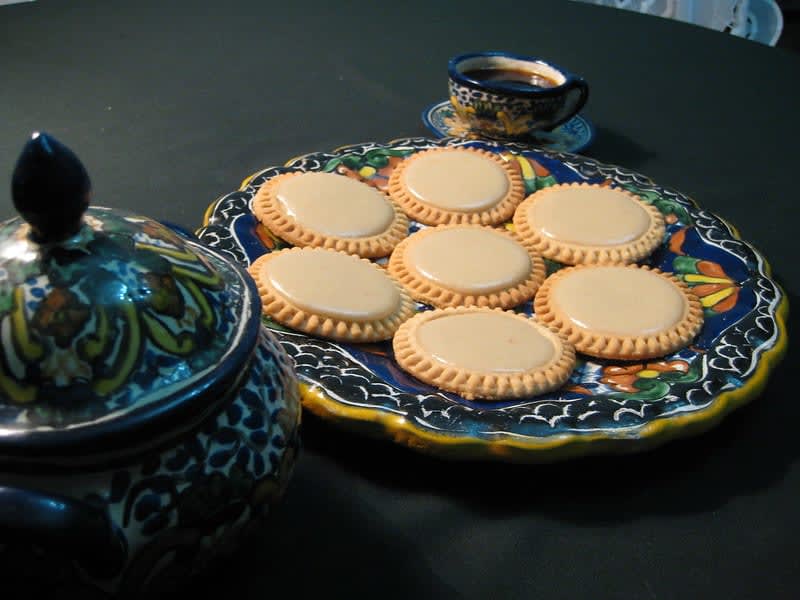
Finally, we have these delicious cookies from Puebla, made over 400 years ago by the different nuns who lived in the surrounding convents.
These vanilla cookies are covered with piloncillo de pepita, making them a favorite dessert for tourists visiting Puebla.
Interestingly, these cookies were used as a symbol of a proposal, offering the great love couples had for each other.
How romantic!
Top 20 Mexican Candies: Conclusion
In conclusion, Mexican candies offer a unique and diverse flavor experience that every candy lover should try.
From spicy and savory to sweet and fruity, the top 20 Mexican candies highlighted in this post will tantalize your taste buds and leave you wanting more.
Whether you prefer traditional favorites like Mazapan and Glorias, there is something for everyone to enjoy.
So next time you’re looking for a sweet and satisfying snack, try one of these delicious Mexican candies and discover a whole new world of flavor!
Don’t forget to buy some to take home (they can make great souvenirs). You’ll be supporting all those who make these delicacies possible.